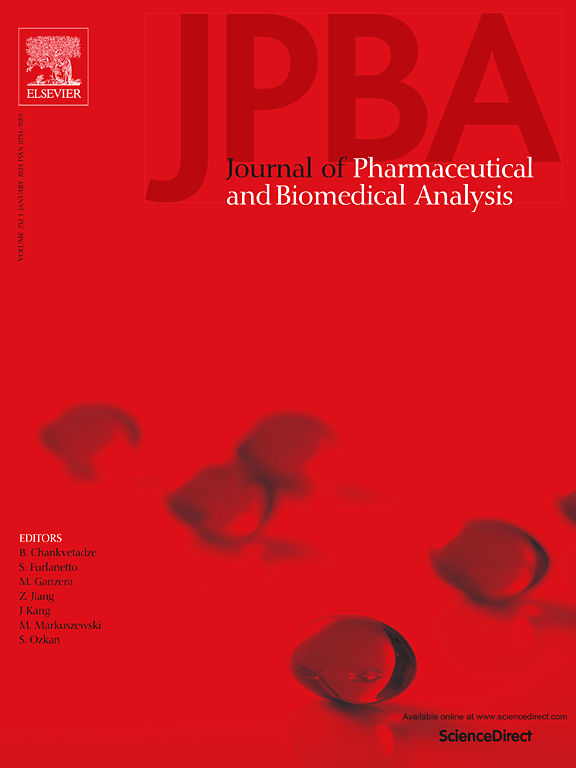冠状动脉左前降支结扎诱发心肌梗死大鼠血浆和尿液代谢谱的动态变化及中成药的调控作用 辛克树
IF 3.1
3区 医学
Q2 CHEMISTRY, ANALYTICAL
Journal of pharmaceutical and biomedical analysis
Pub Date : 2024-09-26
DOI:10.1016/j.jpba.2024.116483
引用次数: 0
摘要
心肌梗死(MI)是最严重的心血管疾病(CVD)之一。中药在治疗心血管疾病方面具有独特的优势,其中心可舒是预防和治疗心肌梗死患者的常用中成药。本研究旨在探讨冠状动脉左前降支结扎术(LAD)诱导的心肌梗死大鼠术后第3天、12天和21天血浆和尿液的动态代谢谱,并采用超高效液相色谱-四极杆飞行时间质谱(UPLC-Q-TOF/MS)代谢组学方法评估心可舒在这些时间点的调节作用。LAD 诱导的心肌梗死大鼠的血浆和尿液代谢谱在心肌梗死后第 3、12 和 21 天出现了显著变化。我们共发现 23 种血浆代谢物和 12 种尿液代谢物是与心肌梗死进展相关的潜在病理标记物。这些代谢物主要涉及TCA循环、花生四烯酸代谢、谷胱甘肽代谢、甘油磷脂代谢、鞘脂代谢和脂肪酸代谢等途径,所有这些途径都与心肌能量代谢失衡、氧化应激和钙超载有关。早在心肌梗死后第 3 天,血浆和尿液中的 TCA 循环、花生四烯酸代谢、谷胱甘肽代谢和嘌呤代谢就出现了紊乱。到第 12 天,我们发现血浆和尿液中的脂肪酸代谢发生了显著变化,血浆中的鞘脂代谢也发生了明显改变。血浆甘油磷脂代谢紊乱在第12天首次显现,并在第21天达到高峰。用 XKS 治疗可明显调节 MI 大鼠在第 3、12 和 21 天的血浆和尿液代谢紊乱,其中中等剂量的 XKS 显示出特别强的调节作用,尤其是在第 12 天。我们的研究表明,在心肌梗死后,宿主的新陈代谢会发生动态变化,大多数新陈代谢紊乱都表现在心肌梗死的早期阶段。XKS 可有效调节几乎所有这些紊乱,并可在心肌梗死后尽快给药。这些发现为了解心肌梗死的代谢进展提供了宝贵的信息,并凸显了 XKS 在治疗心肌梗死方面的治疗潜力。本文章由计算机程序翻译,如有差异,请以英文原文为准。
Dynamic variations of plasma and urine metabolic profiles in left anterior descending coronary artery ligation-induced myocardial infarction rats and the regulatory effects of Chinese patent medicine Xin-Ke-Shu
Myocardial infarction (MI) is one of the most severe cardiovascular diseases (CVD). Traditional Chinese medicines have unique advantages in the treatment of CVD, with Xin-Ke-Shu (XKS) being a commonly used Chinese patent medicine for the prevention and treatment of MI patients. This study aimed to investigate the dynamic metabolic profiles of plasma and urine in left anterior descending coronary artery ligation (LAD) -induced MI rats at days 3, 12, and 21 after surgery, and to evaluate the regulatory effects of XKS at these time points using ultra-performance liquid chromatography coupled with quadrupole time-of-flight mass spectrometry (UPLC-Q-TOF/MS) metabolomics. The metabolic profiles of plasma and urine in the LAD-induced MI rats showed significant variations at days 3, 12, and 21 after MI. We identified a total of 23 plasma metabolites and 12 urine metabolites as potential pathological markers related to MI progression. These metabolites were mainly involved in pathways such as TCA cycle, arachidonic acid metabolism, glutathione metabolism, glycerophospholipid metabolism, sphingolipid metabolism, and fatty acid metabolism, all of which were associated with imbalance of myocardial energy metabolism, oxidative stress, and calcium overload. Disturbances in the TCA cycle, arachidonic acid metabolism, glutathione metabolism, and purine metabolism in plasma and urine were observed as early as day 3 after MI. By day 12, we noted significant changes in fatty acid metabolism in plasma and urine, along with notable alterations in sphingolipid metabolism in plasma. Disorders in plasma glycerophospholipid metabolism were first evident at day 12 and reached their peak severity by day 21. Treatments with XKS significantly regulated the disturbances in the plasma and urine metabolic profiles of MI rats at days 3, 12, and 21, with medium dose of XKS displaying a particularly strong regulatory effect, especially at day 12. Our study demonstrates that host metabolism undergoes dynamical changes following MI with most metabolic disorders manifesting in the early stage of MI. XKS effectively regulates nearly all of these disturbances and can be administered as soon as possible after MI. These findings provide valuable insights into the metabolic progression of MI and highlight the therapeutic potential of XKS in the treatment of MI.
求助全文
通过发布文献求助,成功后即可免费获取论文全文。
去求助
来源期刊
CiteScore
6.70
自引率
5.90%
发文量
588
审稿时长
37 days
期刊介绍:
This journal is an international medium directed towards the needs of academic, clinical, government and industrial analysis by publishing original research reports and critical reviews on pharmaceutical and biomedical analysis. It covers the interdisciplinary aspects of analysis in the pharmaceutical, biomedical and clinical sciences, including developments in analytical methodology, instrumentation, computation and interpretation. Submissions on novel applications focusing on drug purity and stability studies, pharmacokinetics, therapeutic monitoring, metabolic profiling; drug-related aspects of analytical biochemistry and forensic toxicology; quality assurance in the pharmaceutical industry are also welcome.
Studies from areas of well established and poorly selective methods, such as UV-VIS spectrophotometry (including derivative and multi-wavelength measurements), basic electroanalytical (potentiometric, polarographic and voltammetric) methods, fluorimetry, flow-injection analysis, etc. are accepted for publication in exceptional cases only, if a unique and substantial advantage over presently known systems is demonstrated. The same applies to the assay of simple drug formulations by any kind of methods and the determination of drugs in biological samples based merely on spiked samples. Drug purity/stability studies should contain information on the structure elucidation of the impurities/degradants.

 求助内容:
求助内容: 应助结果提醒方式:
应助结果提醒方式:


